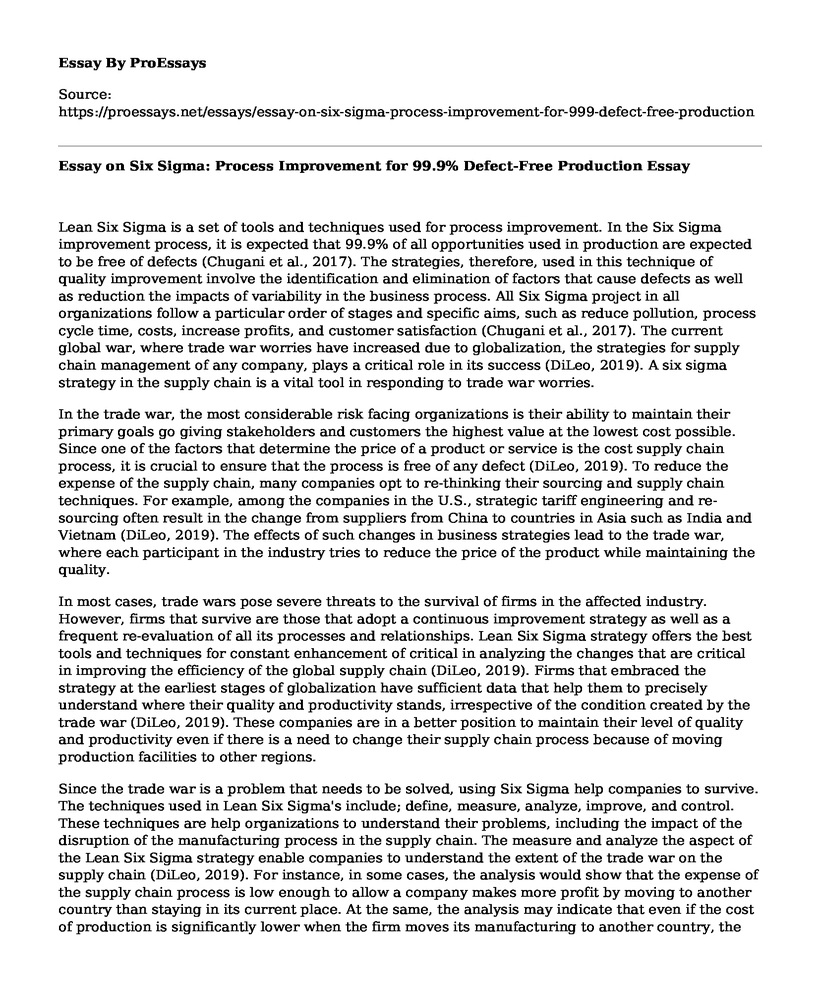Lean Six Sigma is a set of tools and techniques used for process improvement. In the Six Sigma improvement process, it is expected that 99.9% of all opportunities used in production are expected to be free of defects (Chugani et al., 2017). The strategies, therefore, used in this technique of quality improvement involve the identification and elimination of factors that cause defects as well as reduction the impacts of variability in the business process. All Six Sigma project in all organizations follow a particular order of stages and specific aims, such as reduce pollution, process cycle time, costs, increase profits, and customer satisfaction (Chugani et al., 2017). The current global war, where trade war worries have increased due to globalization, the strategies for supply chain management of any company, plays a critical role in its success (DiLeo, 2019). A six sigma strategy in the supply chain is a vital tool in responding to trade war worries.
In the trade war, the most considerable risk facing organizations is their ability to maintain their primary goals go giving stakeholders and customers the highest value at the lowest cost possible. Since one of the factors that determine the price of a product or service is the cost supply chain process, it is crucial to ensure that the process is free of any defect (DiLeo, 2019). To reduce the expense of the supply chain, many companies opt to re-thinking their sourcing and supply chain techniques. For example, among the companies in the U.S., strategic tariff engineering and re-sourcing often result in the change from suppliers from China to countries in Asia such as India and Vietnam (DiLeo, 2019). The effects of such changes in business strategies lead to the trade war, where each participant in the industry tries to reduce the price of the product while maintaining the quality.
In most cases, trade wars pose severe threats to the survival of firms in the affected industry. However, firms that survive are those that adopt a continuous improvement strategy as well as a frequent re-evaluation of all its processes and relationships. Lean Six Sigma strategy offers the best tools and techniques for constant enhancement of critical in analyzing the changes that are critical in improving the efficiency of the global supply chain (DiLeo, 2019). Firms that embraced the strategy at the earliest stages of globalization have sufficient data that help them to precisely understand where their quality and productivity stands, irrespective of the condition created by the trade war (DiLeo, 2019). These companies are in a better position to maintain their level of quality and productivity even if there is a need to change their supply chain process because of moving production facilities to other regions.
Since the trade war is a problem that needs to be solved, using Six Sigma help companies to survive. The techniques used in Lean Six Sigma's include; define, measure, analyze, improve, and control. These techniques are help organizations to understand their problems, including the impact of the disruption of the manufacturing process in the supply chain. The measure and analyze the aspect of the Lean Six Sigma strategy enable companies to understand the extent of the trade war on the supply chain (DiLeo, 2019). For instance, in some cases, the analysis would show that the expense of the supply chain process is low enough to allow a company makes more profit by moving to another country than staying in its current place. At the same, the analysis may indicate that even if the cost of production is significantly lower when the firm moves its manufacturing to another country, the expense in the supply chain will be substantially higher, thus reducing the profitability.
From the above discussion, it is evident that although the main goal Lean Six Sigma process aims at delivering the highest value to customers at an affordable price, the only way to achieve value is through continuous improvement. Firms participating in trade wars should continuously work on improving their supply chain management process as a way of reducing the prices of their products in the market, without undermining the quality.
References
Chugani, N., Kumar, V., Garza-Reyes, J. A., Rocha-Lona, L., & Upadhyay, A. (2017). Investigating the green impact of lean, six sigma and lean six sigma. International Journal of Lean Six Sigma, 8(1), 7-32. https://doi: 10.1108/IJLSS-11-2015-0043
DiLeo, M. (2019, September 18). Responding to trade war worries: A Six Sigma strategy. Supply Chain Brain - Supply Chain News, Analysis, Videos, Podcasts. https://www.supplychainbrain.com/blogs/1-think-tank/post/30212-responding-to-trade-war-worries-with-a-lean-six-sigma-strategy
Cite this page
Essay on Six Sigma: Process Improvement for 99.9% Defect-Free Production. (2023, Apr 09). Retrieved from https://proessays.net/essays/essay-on-six-sigma-process-improvement-for-999-defect-free-production
If you are the original author of this essay and no longer wish to have it published on the ProEssays website, please click below to request its removal:
- Paper Example on Innovation and Information Technology
- Essay Sample on Deep Learning: A Crucial Component of Artificial Intelligence
- Essay Example on Achievements in Flight Test Instrumentation for V280 Aircraft
- Essay Sample on Fixed-Wing Aircraft: Changing Lives & Transforming the World
- Essay Example on Amazon Fire Stick: Enhancing User Experience with Internet of Things
- Essay Example on Children and Mobile Phones: Impact of Globalization & Technology
- Smart Diapers - Free Report Example







